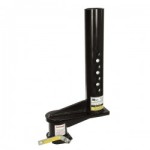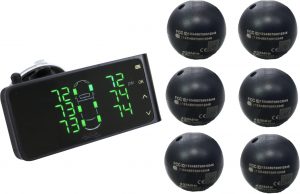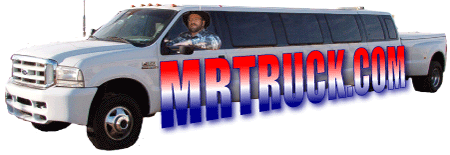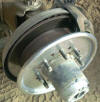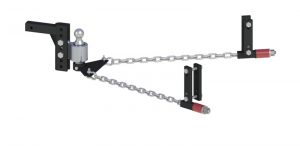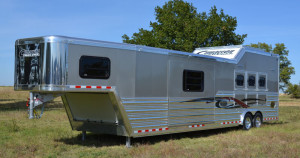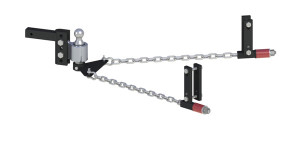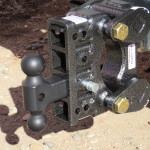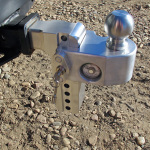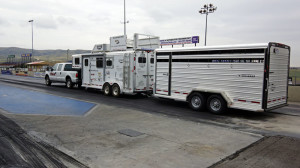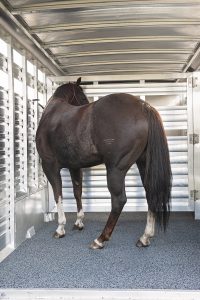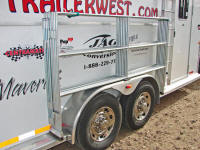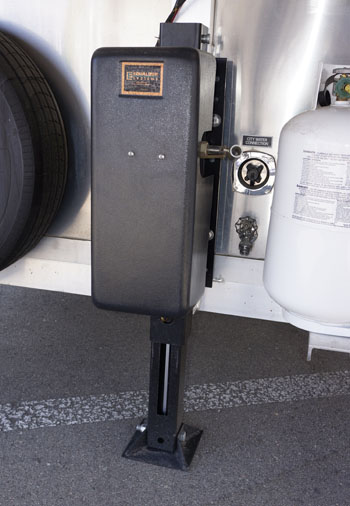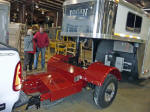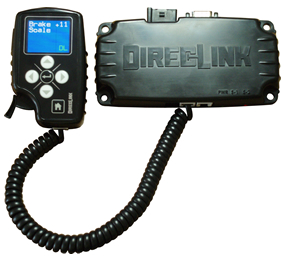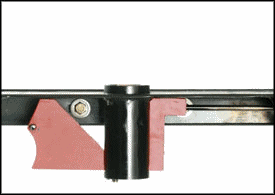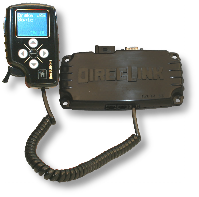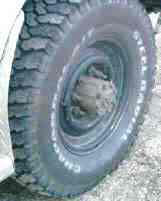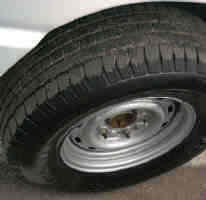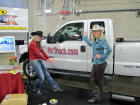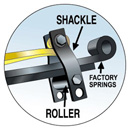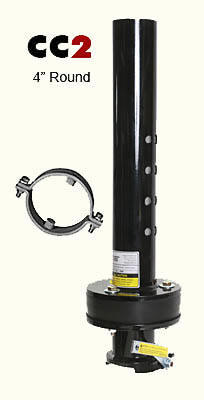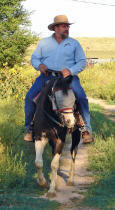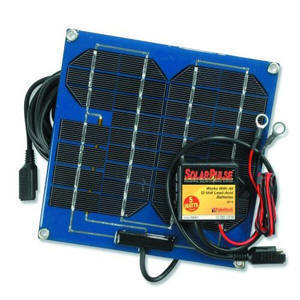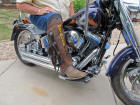Weight Distributing Hitches
WDH is important because it can improve how a ½ ton handles with a trailer and with most truck manufactures it’s required on trailers over 5000 lbs. If it’s required, it can affect your trucks warranty and your insurance claim. Even heavy duty trucks can use a wdh when towing RV’s and cargo trailers that are susceptible to side wind.
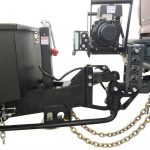
Do you need a weight distributing hitch?
To explain what a WD hitch does, think of it as a bridge between the towing vehicle and your trailer. This bridge comes complete with an adjustable under truss called spring bar/arm or trunnion bars which join the trailer “V” tongue of the trailer to the hitch head and receiver hitch that arches the bridge upward to spread out the weight. The hitch head with the trailer ball attached to the trailer coupler/hitch, bolts to the shank which is “L” shaped with adjustment holes for proper hitch height. The shank slides in to your receiver hitch which is bolted to the towing vehicle’s frame or sub-frame. This union allows you to distribute the trailer weight evenly to all axles of the truck/SUV and trailer. Thus the name “weight distributing” hitch. The picture here shows the shank, head, spring arms, chains and snap-up brackets with a typical WDH.
I adjust my WDH by feel, but you can weigh your truck empty and then weigh it with a trailer to get the trailer weight, then just weigh the truck on the scale with the trailer off the scale. That will tell you the tongue weight. Adjust your WDH for 10 – 15% tongue weight of your loaded trailer. If your WDH spring bars too tight, it is possible to move too much weight to the front axle and loose traction on your trucks rear axle on say a slippery boat ramp or mud and snow. Another rule of thumb is to measure the distance between your truck fender wells and tires without load and adjust the rear tire measurement (by adjusting the spring bars) to drop an inch lower than the front axle when loaded. An important note here is that most vehicle manufactures will only allow a maximum trailer capacity of 5000#’s and 500#’s of tongue weight without using a weight distributing hitch. No weight distributing hitch will increase the total trailer capacity set by the vehicle manufacture, it just transfers the weight to all the axles including the front axle of your tow vehicle. This gives you better steering control and a level rig.
The two hitch types you’ll see on the tag on your receiver hitch is WC which is weight carrying as in drawbar and WD which is weight distributing. Basically weight distributing consists of a shank that fits into your receiver hitch, the hitch head which attached to the shank with the ball on it, the spring arms or trunnion bars which are long bars that attach to the hitch head and to the trailer tongue at the trailer hitch brackets.
When the spring arms are lifted up on the trailer tongue brackets by chain or L-brackets, it forms an under truss like a bridge between the towing vehicle and your trailer, lifting up the truck receiver hitch and trailer tongue. This redistributes tongue weight forward to the trucks front axle and rearward to the rear tire of the trailer. Thus the tongue weight now is distributed to all truck and trailer axles.
Do you need a weight distributing hitch?
Sway control for WDH is mostly friction. Something rubs on something else if the trailer moves side to side. This is to control how fast and far the trailer pivots on the truck ball. By lifting the connecting point between the truck and trailer, tension exists. Add that to friction sway control and sway can be slowed down but not prevented. Don’t forget what we covered in chapter 4 about controlling trailer sway with the manual override on the trailer brake controller in your truck in an emergency.
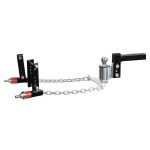 Andersen WDH uses chains instead of spring arms and uses neoprene bushings to take out the bounce of driving and has a beveled hitch head ball that pushed down into a bushing for sway control.
Andersen WDH uses chains instead of spring arms and uses neoprene bushings to take out the bounce of driving and has a beveled hitch head ball that pushed down into a bushing for sway control.
Old school WDH sway control is a sliding plate attached to the hitch head and trailer tongue with ball and socket. The slider has to be tightened to provide sway control friction and needs to be loosened in bad weather or when backing up.
This WD hitch has a friction type anti-sway bar. But instructions may tell you to loosen sway bar during rain or snow on some brands. That’s when I want anti-sway the most. And more bolts to drill into the trailer hitch. But this is the cheapest system of the three types of sway control.
The first place I remember seeing the WDH hitch is with folks pulling RV travel trailers. Which used to be the gray haired, retired, fixed income conservative types. (Always watch this group, they seem to know something.) These big square travel trailers catch a lot of side wind and do the Elvis pelvis hip action when semi-trucks pass them. The RV world has embraced using WDH for decades for the safety and handling reasons.
Horse trailers are the final frontier for broad use WDH. And hauling live tall animals need WDH the most for having a high center of gravity. It would the easiest place to see the dramatic improvement the WD hitches can add better steering control and braking that, a level stable rig provides. I know it’s one more thing to do when you hook up and you may have to cut a slit in the nice tongue cover for the spring bar brackets, but it is an important safety measure. I applaud the horse trailer manufactures who already have a boxed cutout in their tongues for a WDH. A good properly adjusted WDH can take the sway, pitch and dip away from your trailer trying to react to wind, semi suction, pot holes and my favorite “swerving to miss the black Angus cow crossing the road at midnight.”
You can’t control the other drivers or debris in the road. So when you need to do those quick lane changes to avoid an accident, be sure your trailer will recover from that quick movement without taking you down the ditch and over. Horse trailers need it, boat trailers need it and there’s a reason so many RV travel trailers have them. I see more and more enclosed car haulers in Colorado using WD hitches. WDH can do more to safely leveling your sagging vehicle rear end than all the springs, shocks and air bags combined. The WD hitch also places the trailer a few inches back to give you more room for a tight turn.
Trucks are getting longer rear springs for a better ride, but that can mean more rear end sag. SUV’s have mostly gone to independent rear axles and coil springs replacing leaf springs. This can create more sway increasing the need for weight distributing hitches. dramatic improvement the WD hitches can add for better steering control and braking that, a level stable rig provides.
Do you need a weight distributing hitch?
A level load will allow all of your brakes, wheel bearings, springs and tires to help with the load. The GAWR can’t be changed as with all the capacity maximum factory ratings. They are set by the manufacture and is considered the rule. If the rig pulls well, you are close to balanced. Since the GAWR can’t be changed, use the spring bars to move weight between the tow vehicles axles. You can lift the spring bars on your WDH a notch before you weigh it again. Lifting the spring bar (trunnion bar) will transfer some weight to the front axle. But if you move to much weight forward you can lose traction on the rear axle. So that’s the adjustment you have to fine tune. You can add air shocks, or overload springs etc. if you want more support on the rear axle. None of that will though increase the capacity. But the WDH adjustment is the best thing to do for supporting the weight. Adding springs, shocks, air bags etc. doesn’t change the GAWR or any of the weight ratings. Which is why I believe the WDH is the best trailer tool for a ½ ton truck. The axle ratings on the door tag is the maximum for each axle that you want to be under.
Using the trailer jack to lift up the trailer tongue can help when attaching the spring bars to the trailer tongue chains or brackets. The same thing can help take the pressure off the spring bars when un-hooking.
The trend is the independent rear suspensions coming to SUV’s and crossovers. They ride great but all that extra movement for the soft ride, will let a trailer move more. The coil spring suspensions found on most SUV’s also allow more trailer sway. So I highly recommend using a WDH. The better ones are easy and fast to hook up. Watch the retired gray hairs pulling RV travel trailers. 80% of them will have a WDH. And their cargo doesn’t shift weight from one hoof to the other while swatting flies with its tail.
I relate most of my towing experiences with going up and down hills. We have some tall hills in Colorado with snow still on them in the summer. Going downhill with a trailer pushing you and trying to steer you can get spooky. You will see semi-trucks adjust their weight with sliding 5th wheel hitches and sometimes sliding trailer axles. This is a good idea with your trailer also. Being able to adjust where the weight is distributed on your truck and trailer will give you a level rig allowing all the axles and brakes to work for you.
Haul Gauge, on board truck scale
Glossary Terminology for Truck, SUV Payloads and Trailer Weights
